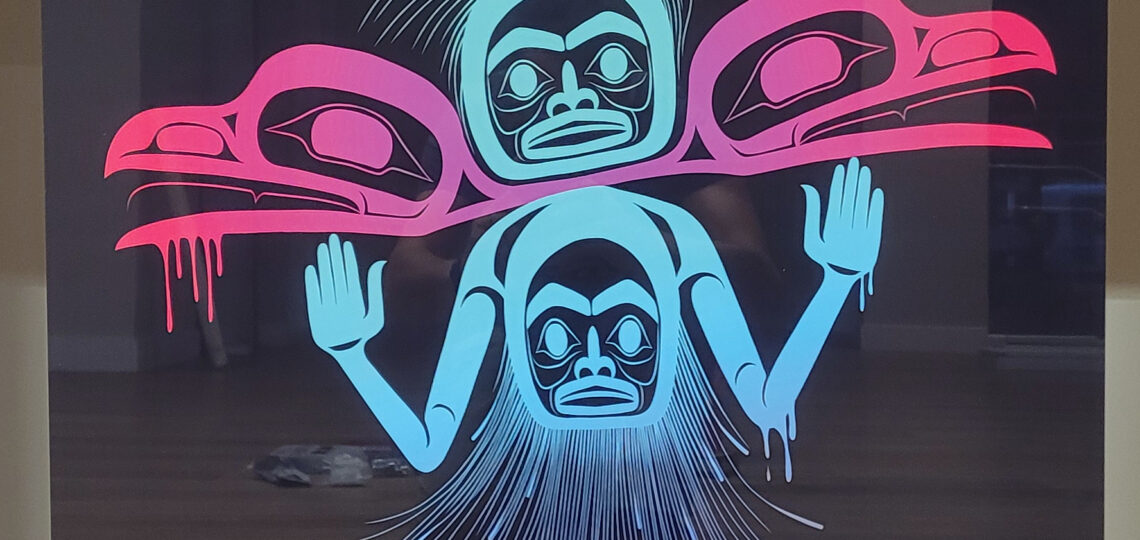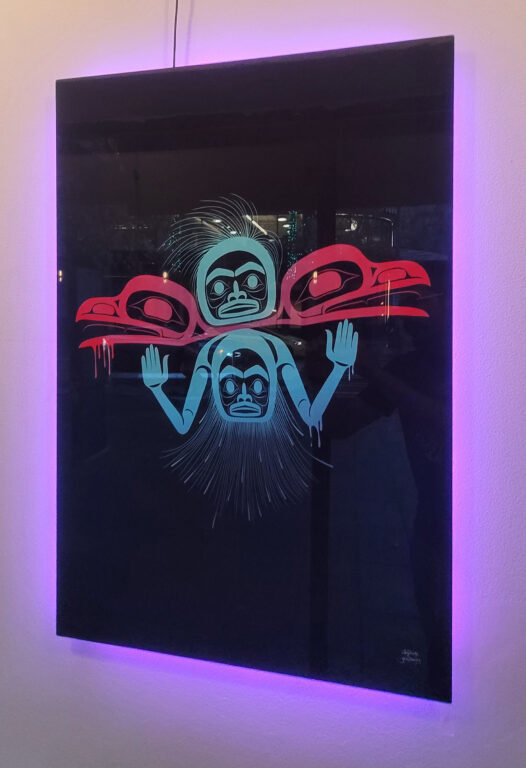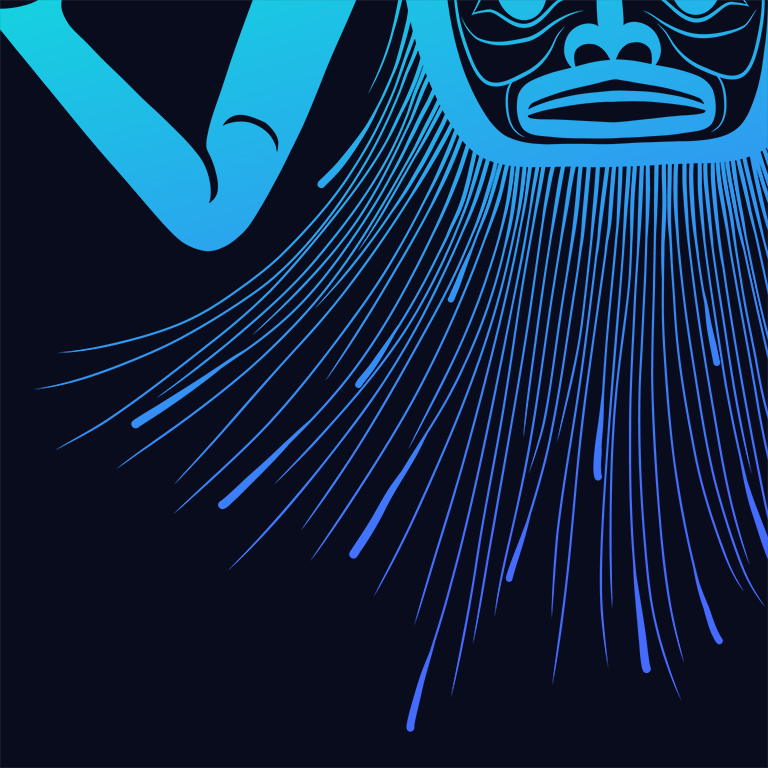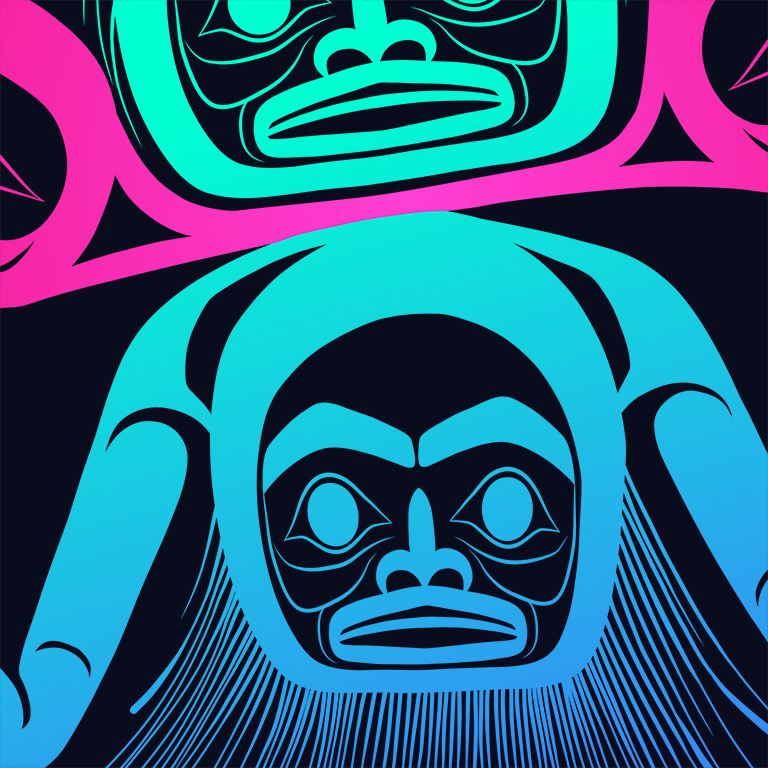
Tlingit Raven Dancer: Tradition, Transformation, and the Power of Storytelling
This is part of the Neon Series, currently installed at 5th and Pike in downtown Seattle until May, 2025 as part of a partnership with Seattle Restored. Make sure to check out the others in the series. Merchandise featuring these are available in the store. If interested in purchasing the large format with neon lighting, contact me through the my online contact form, Instagram or Facebook
I want to introduce you to a piece that is a culmination of everything that has come before it, a piece that seeks to honor the rich traditions of my heritage, and to speak to the transformative power of storytelling and dance. Today, I invite you into the vibrant and deeply personal world of “Raven Dancer.” This artwork is more than just an image; it’s a celebration of cultural heritage, a testament to personal history, and a powerful reminder of the interconnectedness of all things. It’s a piece that asks us to embrace the present while honoring the past, and to move into the future with our hearts open.
“Raven Dancer” is the sixth and final installment of my art series, and it holds a special place in my heart. It is a culmination of my journey, and it seeks to honor the cultural traditions that I hold so dear. This piece seeks to capture the essence of traditional Tlingit dances, dances that were more than mere performances; they were vital rituals for preserving and transmitting cultural knowledge. They were an integral part of everyday life. These evening dances inside traditional longhouses during the winter season were a vital part of Tlingit life, serving as a means to pass along important cultural information, often specific to the clan within the household, and to tell stories from myth time, including tales of how the world was created and how different animals played pivotal roles in the histories of Southeast Alaska. These dances are a part of who we are, a way to connect with those who came before us.

“Raven Dancer” installed with neon lighting
A Central Figure in Motion: Capturing the Essence of Dance
At the heart of this piece is a central figure, depicted in the midst of dancing. The figure is adorned in traditional regalia, complete with flowing fringes and tassels, their hair wild and free, capturing the dramatic motion of the dance. The fringes draw inspiration from traditional leather dance aprons and Chilkat aprons, weaving a tapestry of cultural significance into the visual narrative. They also capture the wildness and freedom of the spirit, a reminder that we must allow our spirits to be free. The visual narrative of the piece seeks to highlight this freedom and expression, and to showcase the ways in which cultural traditions have shaped who we are as a people.

Dance apron full of fringes in motion
Within the belly of this central figure lies an ancestor face, symbolizing the lineage and enduring spirit of the Tlingit people. This incorporation of ancestral imagery serves as a poignant reminder of the deep-rooted connections that bind us to our past, and the idea that we are never truly alone but are always accompanied by the spirits of our ancestors. It is in this connection to the past that we find our sense of belonging. The subtle form within the central dancer is a reminder of all those who came before us, their love and their wisdom still a powerful influence in our lives. They are not separate from us, but are a part of us.
This element of connection and heritage is not merely decorative; it is essential. It serves as a link to our past, reminding us that we are not separate from those who came before us. This visual element is a reminder that our traditions are not merely things of the past, but are a part of our living present.

Ancestor face within the stomach of the dancer
Ravens in Contrasting Hues: A Dance of Transformation
Flanking the central figure are two opposing raven faces, rendered in striking magenta. The dancer, depicted in cyan, creates a vivid contrast that emphasizes the symbolic nature of the mask being worn. This use of color is not simply aesthetic; it is meant to evoke a particular emotional response that amplifies the feelings of joy and freedom. These masks are part of the tradition of transformation masks, which play a significant role in Tlingit storytelling.
These contrasting colors further highlight the idea of transformation that is so central to the Tlingit culture and mythology, a way to emphasize the duality of human existence, and to showcase the many ways that we transform ourselves throughout our lives. They are meant to evoke the feeling of mystery, while also celebrating the deep-rooted spiritual connections that are so deeply ingrained in our cultural identity.
The transformation mask, when closed, conceals the face of the dancer or an internal mask, embodying the Raven’s true form. Upon opening, the mask reveals either the dancer’s face or an internal mask depicting what the Raven transformed into. This duality and the ability to reveal hidden layers of identity and story are central themes in Tlingit mythology. This duality is meant to reflect the complexity of human existence, and the way that our stories change and transform as we do. The mask represents the idea that we all have many layers, and that we must learn to embrace all of them.
One such story reflects the Raven’s transformation into a pine needle, which fell into the tea of a chief’s daughter. Upon drinking the tea, the girl became pregnant, eventually giving birth to a human boy—the Raven in human form. The chief, overjoyed by the birth of his first grandson, showered the boy with gifts. One evening, as the chief reached his wits’ end with the boy’s mischief, he allowed him to play with the bentwood chest containing the sun and the stars, which Raven lifted the lid, releasing them into the world. This transformation mask is danced in storytelling, symbolizing Raven’s duality and his pivotal role in Tlingit creation myths. This story represents the ability of the Tlingit people to adapt and to overcome the hardships that they face. It also highlights the creativity of the Tlingit spirit, and their willingness to find beauty and meaning in all things.
Personal Roots in Tradition: A Legacy of Love
Reflecting on my childhood, my connection to these traditions is deeply personal. My father and my sisters were actively involved in a traditional Tlingit dance group in our hometown in Southeast Alaska. Being a Tlingit tribal member, my father found it crucial to engage my sisters in these cultural practices, ensuring they were imbued with knowledge of their heritage. This personal experience has profoundly influenced my artistic vision and the creation of “Raven Dancer”.
The creation of this piece is not just about me, but is an ode to the ways that our communities uplift one another and the importance of maintaining those connections throughout generations. It’s a representation of the importance of family and of the love that is shared between members. It is a recognition that we do not exist in a vacuum but that we are all connected to one another.
This piece is also an act of honoring my father’s love, his commitment to sharing our culture and the pride that he took in doing so, his example will always be an influence in all that I do.

One side of the raven mask representing my sister being lifted in her culture
Symbolism and Personal Connection: A Shared Narrative
As I reflect on this piece, I realize that the central figure could be likened to my father, with the open mask symbolizing my sisters. His hands, gently lifting the mask, are symbolic of his role in helping them understand and embrace their Tlingit culture. The imagery of graffiti-like drips adds a contemporary layer, which can be interpreted as blood or sweat, representing the effort and dedication that goes into the art and craft of intentional dancing and storytelling. This also adds a very personal layer to the piece, connecting it with my own experience and giving the viewer an understanding of the profound importance that this dance has held in my own life.
This imagery symbolizes the work and dedication that are required to maintain our cultural traditions. The sacrifices we all must make to share these traditions with our families and communities. These graffiti-like drips are not merely visual; they represent the effort and dedication that are required to keep our traditions alive.
A Reflection on the Series: A Journey of Discovery
The Neon Series has been a journey through time, culture, and personal discovery. Each piece has invited you to reflect on the stories, themes, and symbols presented, challenging you to see beyond the surface. How do these artworks resonate with your own experiences and perceptions? What connections can you draw between the traditional and the modern, the personal and the communal? These are all questions that I have asked myself along the way, and that I hope that you will ask yourselves as well. This journey through art is a journey of self-discovery.
As you navigate these stories, I encourage you to dive deeper into each work, uncovering the layers of meaning and emotion woven into the fabric of Tlingit culture and my personal journey. Your exploration of the Neon Series is not just an observation but an invitation to engage, reflect, and connect.

T-shirts available for purchase through the store
Final Thoughts: A Legacy of Heritage
“Raven Dancer” stands as a testament to the power of art to convey cultural heritage, personal history, and the intricate layers of identity. It is a tribute to my father’s dedication to passing on our cultural knowledge and to the transformative power of dance and storytelling. It is a celebration of life, in all its beautiful and tragic moments, and an ode to the need for all people to find a way to connect to their past while embracing their future. As the final piece in this series, it encapsulates the journey of self-discovery, cultural preservation, and artistic expression, and reminds us that our stories are not just our own, but are a part of something much bigger than ourselves.
Through “Raven Dancer,” I hope to honor the legacy of the Tlingit people and inspire others to delve into their own cultural narratives, finding beauty and meaning in the stories that shape our lives. This piece is not just an end but a new beginning—a reminder that our heritage continues to live and breathe through the art we create and the stories we tell. The stories that we tell are a part of us.
Previous Art Description: Neon Series: Shaman Mask
Next Art Description: Neon Series: Wolf Mother
Head back to the Neon Series Overview Blog
Check out the awesome Neon Series merchandise available in the store

